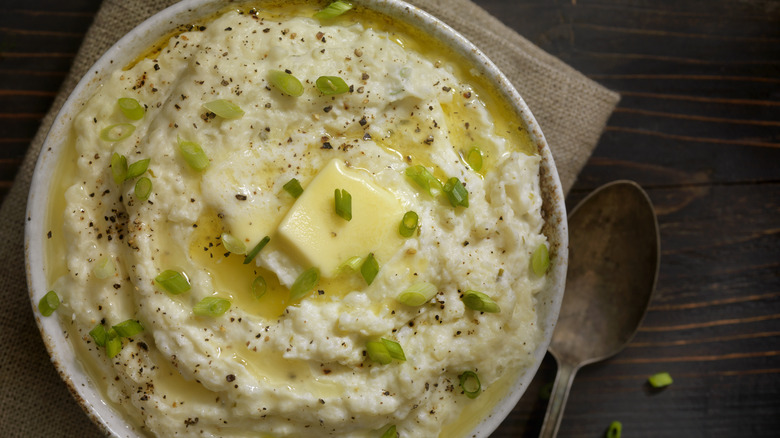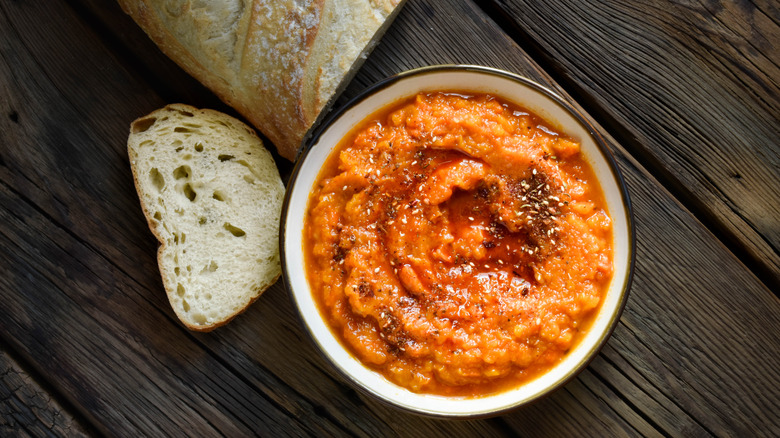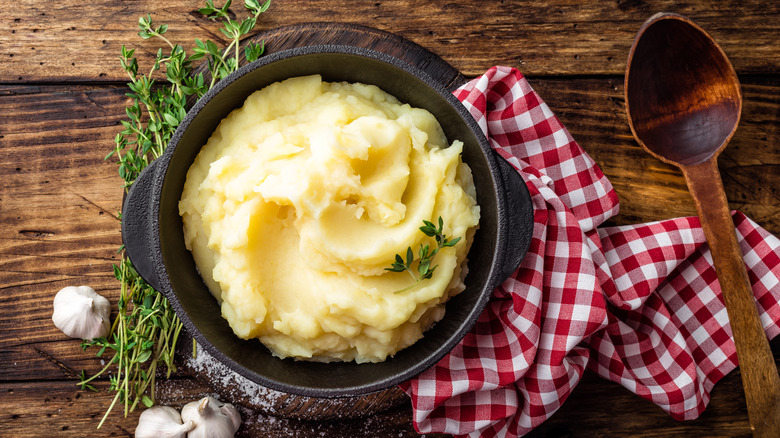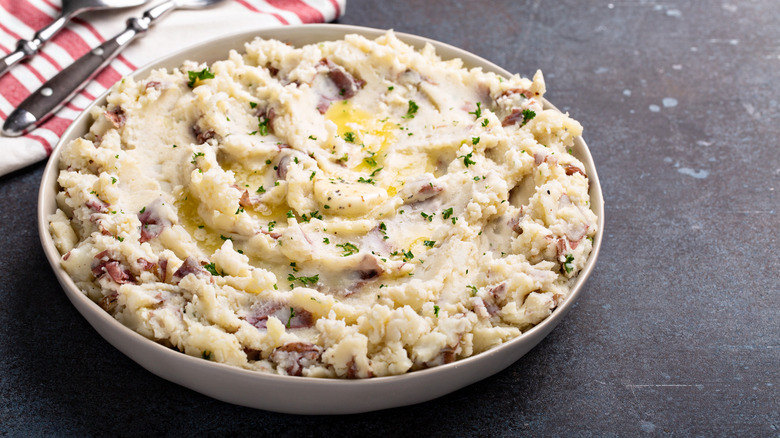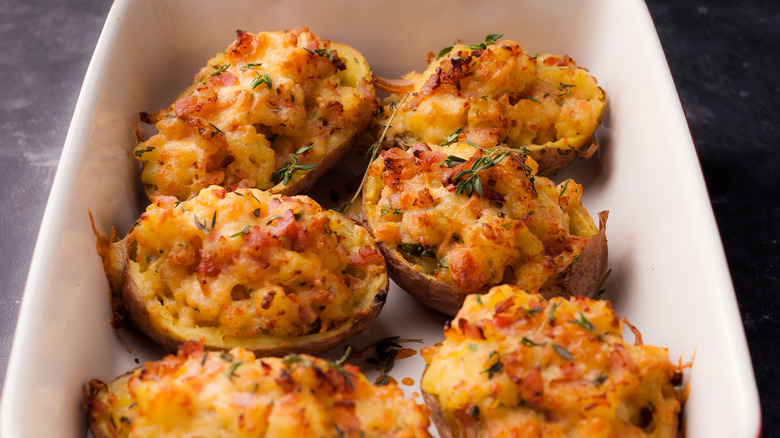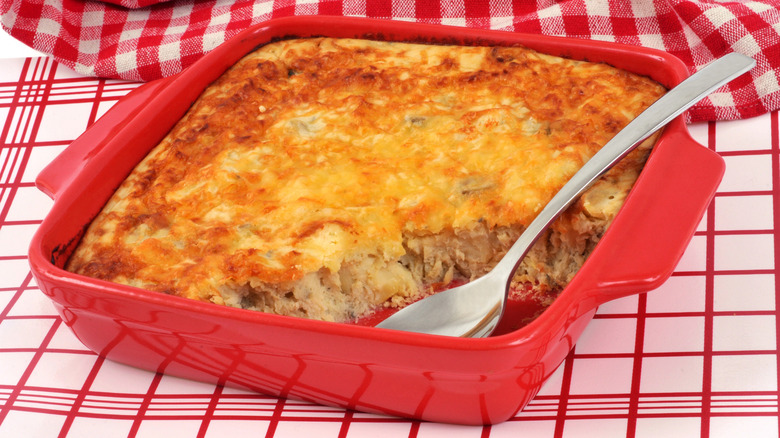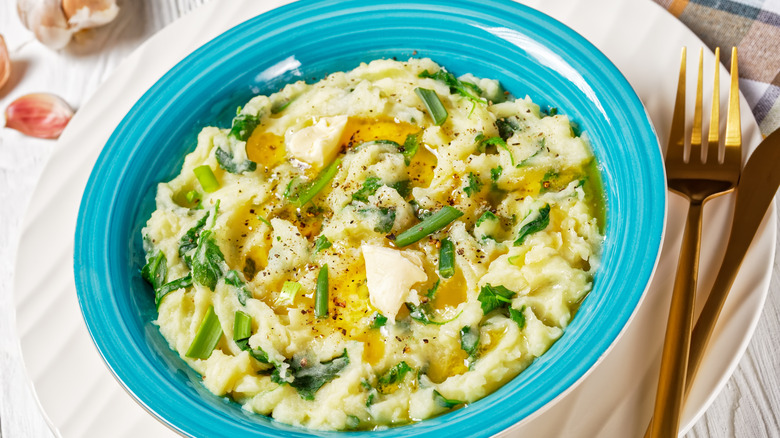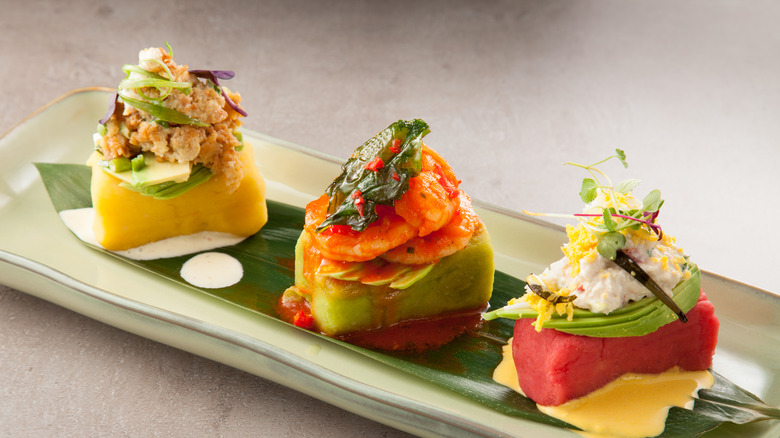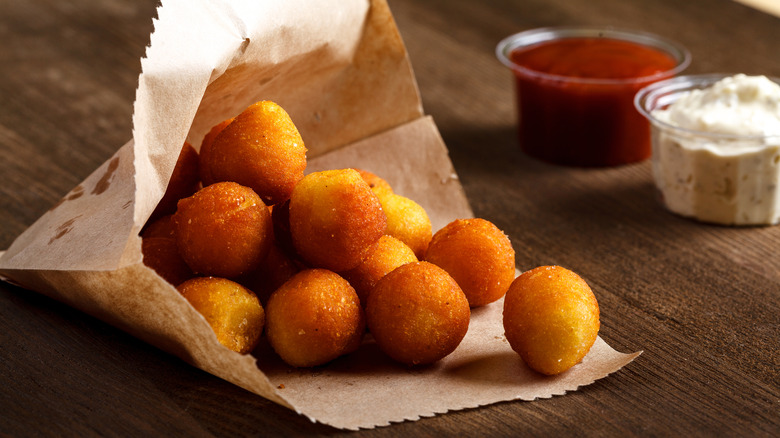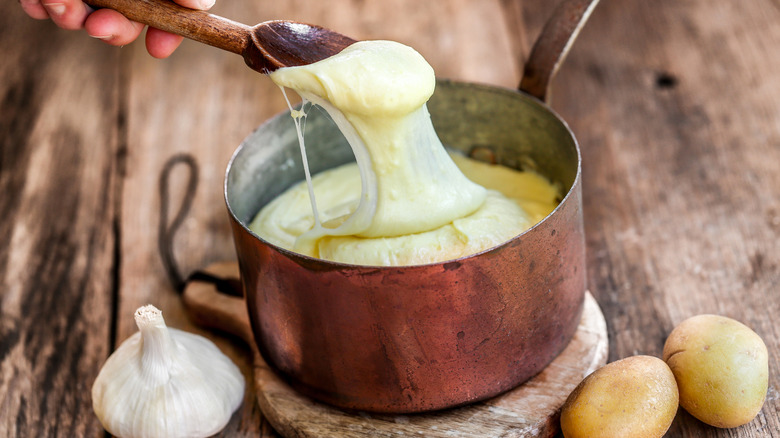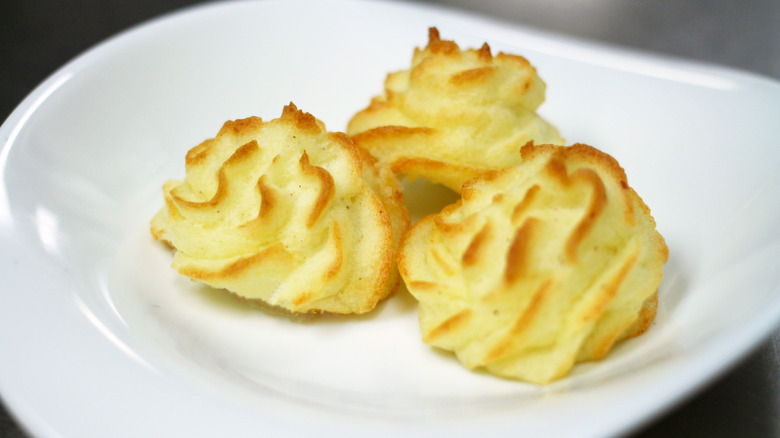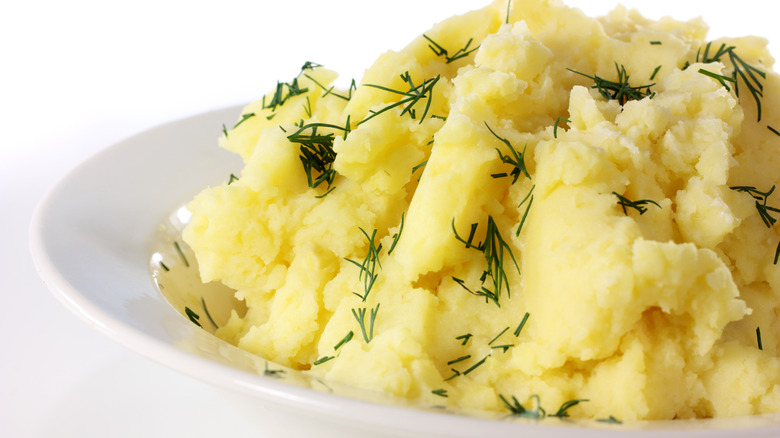The Most Iconic Styles Of Mashed Potatoes, Explained
Mashed potatoes are a classic example of how simplicity can be spectacular — a mound of buttery mashed spuds is appealing to everyone, from picky toddlers to epicures seeking a subdued foil to richer, more intensely flavored dishes. But much as we love mashed potatoes, we also tend to sell them short — too often, the term "mashed potatoes" tends to get thrown around as a synonym for blandness and predictability.
This is unfair. The truth is that mashed potatoes can be far more varied and interesting than most people think. Creative cooks worldwide have taken the humble dish and enhanced it with their own signature touches, turning mashed potatoes into regional specialties that reflect the cultures and places of their origin. So to inspire your exploration into the full potential of the humble dish, we present a few of the world's most iconic mashed potato dishes. Some will no doubt be familiar favorites, but you may also discover some new and surprising variants that will earn regular places on your dinner table. Which of these will become your new favorite?
11. Mashed potatoes and carrots are a home-cooking classic
If you've never tasted this under-the-radar dish or seen it on a restaurant menu, it's likely for the same reason you don't often see tater tot hotdish or tuna casserole on restaurant menus — because those who enjoy these dishes tend to make them at home, and therefore see no need to order them when they go out. This mashed potato variant — in which potatoes are simply mashed together with cooked carrots to form a savory orange puree — is a favorite of home cooks in the Netherlands (where it's called hutspot) as well as in Quebec, Canada.
What makes it iconic is that it's been around for hundreds of years, likely starting in Holland in the 1600s, and thus a well-established facet of culinary tradition, according to Dutch Review. It's far from glamorous or exotic, but it makes a tasty (and budget-friendly) accompaniment to roasted or grilled meats. And, if you're a parent of small children who struggles to get them to eat vegetables, this kid-friendly mash can be a useful tool in your arsenal.
10. Garlic mashed potatoes go with almost everything
Even if you're not a huge fan of garlic, you may have had garlic mashed potatoes and thoroughly enjoyed them. This is because if the garlic is prepared correctly – slowly roasted or blanched until tender before being mashed into the potatoes — they'll end up contributing a pleasantly savory note with none of the breath-destroying sharpness you might associate with garlic.
Garlic mashed potatoes is the rare classic of the French kitchen that was adopted pretty much unchanged by American cooks. A probable reason it caught on in the U.S., besides its tastiness, is it's easy to make (just like regular mashed potatoes, but with cooked garlic mashed in). It's also a fun change-up from plain mashed potatoes but can slip easily into the same roles, going just as well with meatloaf or fried chicken as plain mash. It's different enough to be interesting to your foodie friends but familiar enough not to freak out any picky eaters who show up for dinner. This quiet reliability has made garlic mashed potatoes an iconic dish for home cooks on both sides of the Atlantic.
9. Chunky mashed potatoes are a rule-breaking winner
While classic formal cooking rules dictate that mashed potatoes should be pure white and silky smooth, more recently another, more rustic style has emerged: mashed potatoes with visible un-mashed chunks remaining, often with the potato's skin still in evidence. This variant, which makes frequent appearances on restaurant tables, is often made with red-skinned potatoes, which are not only waxier and more likely to hold together than the mealier russets recommended for smooth mashed potatoes but offer an interesting visual contrast between the chunky white mash and the shreds of red skin.
It's hard to determine where or when this variant originated, but most recipes for this style seem to come from U.S.-based cooks. This makes sense, since chunky mashed potatoes seem to reflect several iconic American values: a desire to save time and work, a cheeky shamelessness about cutting corners if you can still get good results, and a willingness to go against age-old prescriptions, such as the lump-free standard for mashed potatoes. And while some fans of this style wax eloquent about how the skins add color, texture, and added nutrients to the finished dish (and all of this is true), we all know the real reason: No one feels like breaking out the peeler. And we're not going to judge anyone for that.
8. Twice-baked potatoes combine crunch and creaminess
We'll go on a limb and argue that twice-baked potatoes are indeed a form of mashed potatoes since it's impossible to make them without mashing the potatoes involved. But, it's easy to miss the connection between twice-baked and mashed potatoes, since this steakhouse favorite is anything but mushy. Besides the soft interior studded with bacon, cheese, and other flavorings, there's the crispy, browned top and the crunchy potato skin holding the rich filling in place.
Versions of twice-baked potatoes have been around since the 1880s (a recipe from that era flavors the filling simply, with just cheese, breadcrumbs, butter, and spice), as Bite From The Past notes. But, it's the version we know today — that doubles down on all the classic bold fillings for loaded baked potatoes (bacon, cheese, scallions, and sour cream) — which has become an American icon. The flavor profile evokes fun and casual celebrations with friends and families. And, twice-baked potatoes are an ingenious way to make use of leftover baked potatoes.
7. Brandade - mashed potatoes for seafood lovers
Leave it to the French to take two traditionally plain and humble ingredients — potatoes and dried salt cod — mash them together, and elevate them into gourmet fare. If the idea of mashed potatoes mixed with reconstituted dried fish sounds baffling to you, that's a good reason to try brandade de morue, a savory spread that's a celebrated specialty in the South of France. Regions of France explains that the dish was invented in the southwestern coastal town of Nîmes in the late 18th century, the original recipe was a careful emulsion of reconstituted, finely shredded dried cod, garlic, olive oil, and cream. Modern recipes typically include pureed potatoes, with some containing equal measurements of potatoes and cod.
This rich, garlicky, savory spread is so substantial it's traditionally eaten as a meal, spread on rounds of fried or toasted bread with a salad on the side. So, if you're among those who can happily make a meal of dippable, spreadable appetizers, brandade needs to be on your must-try list. While it's easy to make at home with a food processor, historically, it required hours of vigorous hand-beating to acquire its characteristic smoothness. And, this is what makes it so iconically French — as it would seem that most French cooks (even those in the 18th century) know that time, skill, and attention can turn the plainest of ingredients into something special.
6. Colcannon - classic Irish mashed potatoes and greens
Some cultures are indelibly associated with certain foods. And, while potatoes are not native to Ireland (they're a New World vegetable first introduced to Ireland in the 16th or 17th century), they were quickly embraced by the Irish, according to Smithsonian Magazine. By the 1700s, they became an important staple food for much of the Irish population — so much so that when a highly contagious potato blight hit Ireland in the 1800s, a million people in the country died of starvation, while half a million others emigrated to the U.S. to avoid a similar fate, as the Library of Congress notes.
Among Ireland's signature potato dishes is colcannon, a rich mixture of mashed potatoes, butter, scallions, and cooked kale or cabbage — the latter two vegetables had long been traditional staples in Irish cuisine. By the mid-1900s, colcannon had become a widespread and beloved dish, even inspiring children to sing its praises in nursery rhymes. And while it's enjoyed year-round, it's a traditional must-have on Halloween when trinkets such as coins, sticks, or other items are traditionally hidden in the mash. Whichever prize surfaces in your helping will foretell your fate for the following year — a stick, for instance, could mean your spouse will beat you. Colcannon may be humble, but what could be more iconic than mashed potatoes that not only move eaters to song, but predict their fate? Plus, the dish is a great help with holiday leftovers.
5. Causa - Peruvian mashed potato salad
In Peru — where residents have been gathering, growing, and cooking with potatoes long before most of the world knew they even existed — cooks have had centuries, if not millennia, to devise creative dishes that take full advantage of the humble potato's potential.So while most of the world envisioned mashed potatoes as hot, fluffy, and rather bland, Peruvian cooks took the opposite tack and created their own truly iconic take on the dish — causa, a mashed-potato dish that seems to break all the rules. For one, it's cold. But, this elegant layered potato salad of seasoned mashed potatoes with a filling that can include tuna, chicken, or crab , among other variations mustn't be overlooked. Secondly, the potatoes are abundantly seasoned, often with the puree of the Peruvian aji amarillo pepper, which lends a golden color and a bit of heat.
Causa is not only tasty and pretty (it's often shaped in ring molds, making each serving exceptionally elegant), it has a fascinating history. Norman Van Aken points out that the meal was invented during the country's 1879 war against Chile, when women providing food for fighters on the front lines devised it using the few ingredients they had readily available. The dish's name, causa (Spanish for "cause") represents the patriotic roots of its origin. While not as well known outside its homeland as it deserves, causa is truly iconic — both for its unique way of elevating mashed potatoes and its history.
4. Pomme Dauphine - fried mashed potato puffs
One of the great things about a bowl of plain mashed potatoes is how it can be a jumping-off point for any number of dishes –- a simple layer of mashed potatoes, for instance, turns leftover meat and gravy into shepherd's pie, and any mash left over after a meal can be creatively repurposed into potato soup, pierogi filling, or other creations. Among the most elegant ways to elevate even the plainest mashed potatoes is an old-school French classic, pommes Dauphine –- golden-brown, deep-fried mashed potato puffs.
What makes pommes Dauphine iconic –- and distinctive from the humble leftover mashed potato cakes you may have tasted –- is the mash is enriched with pâte à choux, the classic French eggy cooked batter used to make cream puffs and eclairs. And, just as the pastry bases for cream puffs and eclairs are puffy and hollow, the little rounds of pommes Dauphine are airy and lighter than plain fried potatoes. They're not often seen on menus anymore, but are comfort food beyond compare, and are well worth trying if you want to expand your familiarity with the French classics.
3. Aligot - a super-cheesy French mash
Cheesy potatoes are a welcome addition to any meal, and it's no secret that adding a bit of shredded cheese — anything from a few subtle spoonsful of grated Parmesan to a hearty handful of Cheddar cheese — to mashed potatoes is a quick and easy way to change up the familiar dish. But, cooks in the Auvergne region in the southwest of France have taken the idea of cheesy mashed potatoes to its logical extreme. They've created a decadent regional specialty called aligot, which is so intensely cheesy it forms strings when you pull on it. Its distinctive creamy, yet elastic texture is due to two main factors: a ginormous proportion of cheese (most recipes call for two parts per weight of potatoes and one part of grated cheese) and thorough beating to ensure a silky-smooth texture — the job of mashing aligot to the right consistency was traditionally considered so strenuous it was delegated to the man of the house.
A big reason aligot is such a point of regional pride in Auvergne is that it showcases one of the region's other specialties, a young, mild cheese called tomme fraîche. Not only does tomme fraîche get seriously stringy when melted, it contributes a subtly tangy taste. It's not easy to find outside France (though some American cheesemakers have attempted to make their own versions, according to SFGate). For this reason, many English-language recipes suggest substitutions such as Gruyere, mozzarella, or Cantal.
2. Pommes Duchesse - mashed potatoes dressed for royalty
Basic mashed potatoes go with almost everything, but sometimes the occasion calls for something a little fancier. When that time comes there's the classic French preparation pommes Duchesse, or duchess potatoes. As its name suggests, it's mashed potatoes dressed up for royalty. While it's made by adding just a few more everyday ingredients to the plain boiled, mashed potatoes, these few additions are all it takes to elevate a simple bowl of mashed potatoes into a special occasion side dish.
To make pommes Duchesse, add cream, butter, nutmeg, beaten eggs, and egg yolks to the potatoes before mashing and combine until smooth. By tradition, the potatoes are piped into individual serving-sized rounds with a large star tip and baked golden. Alternately, you can top a casserole dish of pommes Duchesse with rosettes of the potato mixture and bake and serve that instead.
The eggs not only add richness but help the potatoes hold their shape when piped and baked. Its combination of unapologetic richness and visual refinement is what makes this an icon of the French culinary canon — and a standby item in traditional French restaurants.
1. Classic mashed potatoes are a dependable favorite
Teachers and advanced practitioners in all subject areas know the importance of understanding and appreciating the basics — whether it's color theory and perspective for artists or basic grammar and spelling for writers. Even chefs at five-star restaurants understand the value of remembering proper food handling techniques, knife safety, and basic recipes and dishes. But, while mashed potatoes can take a dizzying number of delicious forms, none are more foundational than the original – a classic bowl of mashed potatoes seasoned simply with salt, pepper, butter, and perhaps a touch of cream or milk.
For many American and European diners, plain mashed potatoes are a synonym for comfort food, a reliable and appreciated standby for busy home cooks, and a go-to side dish when eating out — especially if you're also ordering something meaty and saucy. While you'd be hard-pressed to find anyone who actively hates mashed potatoes, the strongest negative reaction we can imagine to them is "meh." But, for those who wish plain mashed potatoes were a bit more interesting, there are plenty of great variants to try –- but none would be possible without the iconic original.

